I removed one resistor in all mine D10’s. Output dropped about 30% in all modes, but i think it’s still to high
Not sense resistors, but current limiting resistors. But yes, your summary of their function is correct. They’re in series with the LED. The more resistance, the less amount of current that makes it to the LED. Think of it like having one of our FET drivers, but intentionally using really long and thin LED wires (for extra resistance) to keep the amps a bit lower.
The only thing I have done is swap the MCU. Since it appears that the D10 driver is slightly different, unsoldering the MCU and snapping a decent pic of where the traces are running would help confirm if and changes are needed for the firmware (pin reassignments).
One of the locals where I’m doing fieldwork borrowed my modddd D25 and after using it asked me if he could have it for himself. I could not say no☹️. Its either that or my E21A Armytek Elf so opted to give him the D25. I guess I have a reason to buy the Sofirn D25S when it’s available. Hopefully with neutral white SST-40s or high CRI 3535 leds.
So it looks like the D25 has a total current resistance of 0.266 ohm with a measured 2.5A load on high. That’s 1.25A per emitter.
The D10 looks to be 0.333 ohm with a measured 1.9A load on high.
I wonder how many amps it would pull with the current limiting resistors bypassed? I might temporarily try that later just to measure the results. Maybe I’ll try tweaking the total resistance of my D10 to that of the D25 and see what happens.
I’m guessing the resistors act as a cheap thermal limit to prevent overheating since the driver doesn’t have any thermal control. I can’t remember, did anyone have any issues with the D25 getting too hot?
Hmm, does this indicate that the resistors are in-parallel instead of in-series?
Yes, you can see this in the driver pics. The left side of each resistor is shared. The right side is also shared.
Removing one resistor from the D10 changes the resistance from 0.333 ohm to 0.500 ohm. The resistance goes up so lumens go down.
I’m guessing the resistors act as a cheap thermal limit to prevent overheating since the driver doesn’t have any thermal control. I can’t remember, did anyone have any issues with the D25 getting too hot?
As stock, my D25 got very hot. I didn’t think to measure it, but hot enough that I couldn’t hold it. By changing the MCU it could do thermal regulation which helps with how little thermal mass this thing has.
the heat sink is not good on D25, I was told the brightness getting down slowly once it turns on Turbo.
I'd like share my impressions of the D25, too. :-) Actually, it's not real Sofirn light but a non-branded light sold by Sofirn. Sofirn was so kind to offer me a discount to buy the D25 on Amazon DE in return for an unbiased and honest review.
1. Packaging
The D25 comes in a tiny but sturdy box. It lacks some information about its content (and maybe a better design / market appearance, see some design proposals ► here ◄).
Inside the cardboard box I found:
- the D25 flashlight
- the strap with mount (without overhead strap)
- a microUSB charging cable
- a short manual (English only)


2. The flashlight
This is what it looks like when you pull out the D25 from its cardboard box. The light is attached to its mount and can be easily tilted by turning it back and forth. The strap is very simple and lacks a second, detachable overhead strap, so do not expect the D25 to remain firmly at its desired position during sports activities or heavy duty use. A first glance at the D25 reveals its quite simple design with a plastic reflector retainer and the OP reflectors underneath where you can see two coldwhite XM-L2 (5050 footprint) LEDs. Even with an inserted 18650 battery the light weighs no more than 120 grams. Of course, this is due to the fact that the body is made of thin aluminum. The D25 is being operated by a green side switch. To my surprise, its pressure point and tactile feeling was very good whereas the D25's user interface is very uncommon and certainly not to everyone's statisfaction.
According to its manual the D25 is ingress resistant in compliance with IPX6 (water projected in powerful jets (12.5 mm nozzle) against the enclosure from any direction shall have no harmful effects.). That means it is not protected against water ingress by submersion. The lack of sealing rings below the reflector retainer increases the risk of damage by water ingress.




Sofirn encloses their cheapest 18650 battery with nominal 2,200mAh capacity. However, it's still fine for the D25's consumption of current with approx. 2.5A. Threads are totally dry and not well-made / too shallow. Those fins inside the tube are meant for the cable ducting between the LEDs and the driver but they appear to work as "cooling fins", too which is not the best solution as heat would only be transfered onto the battery but not dissipated from the light. After all, the heat transfer is not optimal. During continuous usage both the flashlight and the battery heat up considerately.
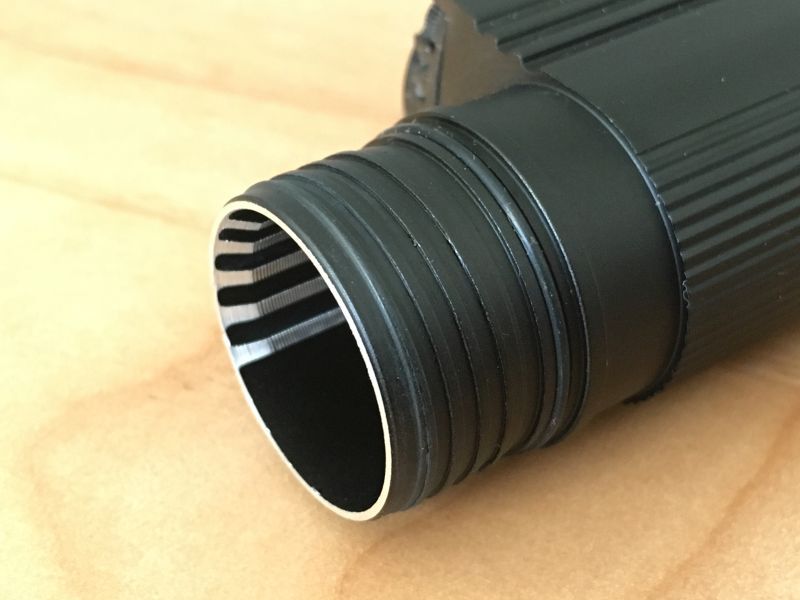

Once you loosen the other cap you will find the microUSB charging port as well as a charging indicator LED. During charging the LED shines red. Once the battery voltage reaches 4.10V is turns green.
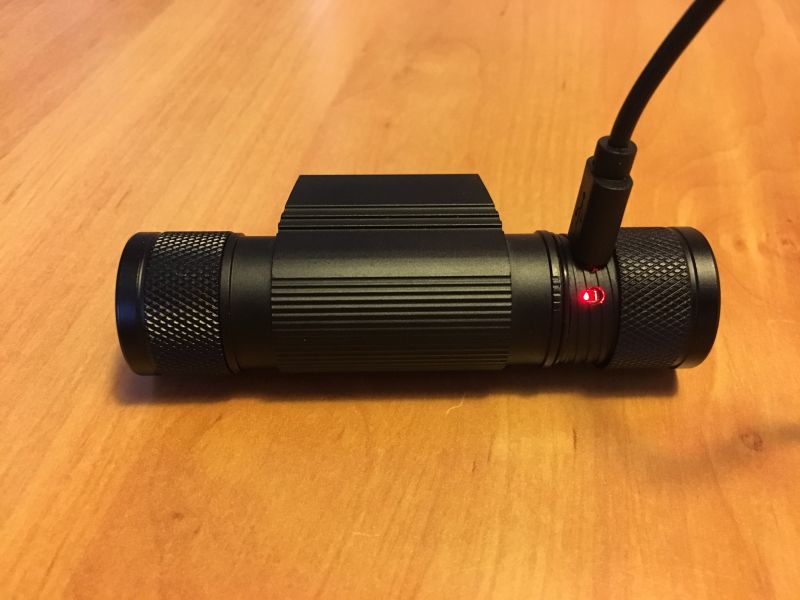
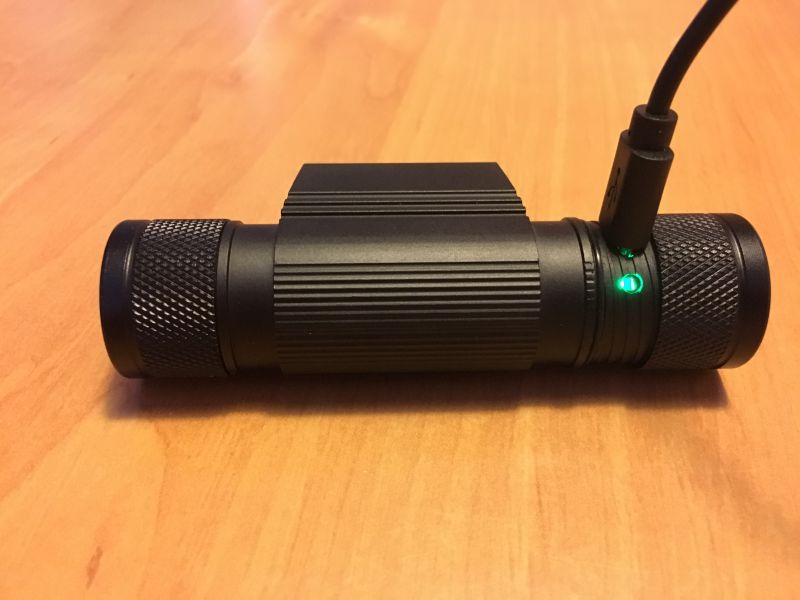
3. Beamshot comparison:
Its greatest shortcoming is - apart from using a real driver that supports better control of current and temperature regulation - the use of coldwhite XM-L2 LEDs. My camera's CCT measurement indicated a colour temperature between 7,000K and 8,000K, thus in a very blueish area of the light spectrum. Those pictures below were taken with a white balance set at 4,000K. I compared the D25 (see first picture below) with the Armytek Wizard Pro V3 warmwhite, the Olight H2R neutralwhite and the Imalent HR70 neutralwhite (and greenish :-D ).
Both reflectors create a quite uniform light beam with a concentrically and rather big but hazy hot spot. It is surrounded by a big, floody and even more blueish spill. Due to its high proportion of blue light the light appears very bright.
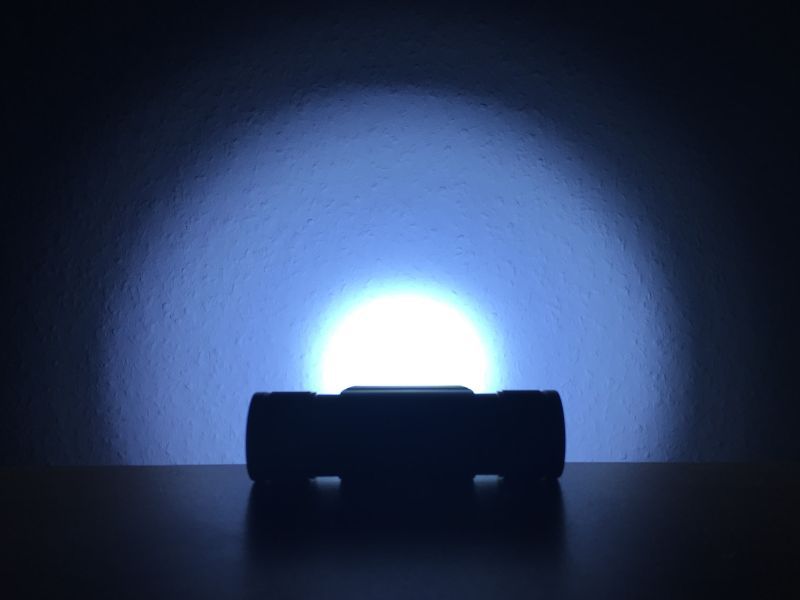
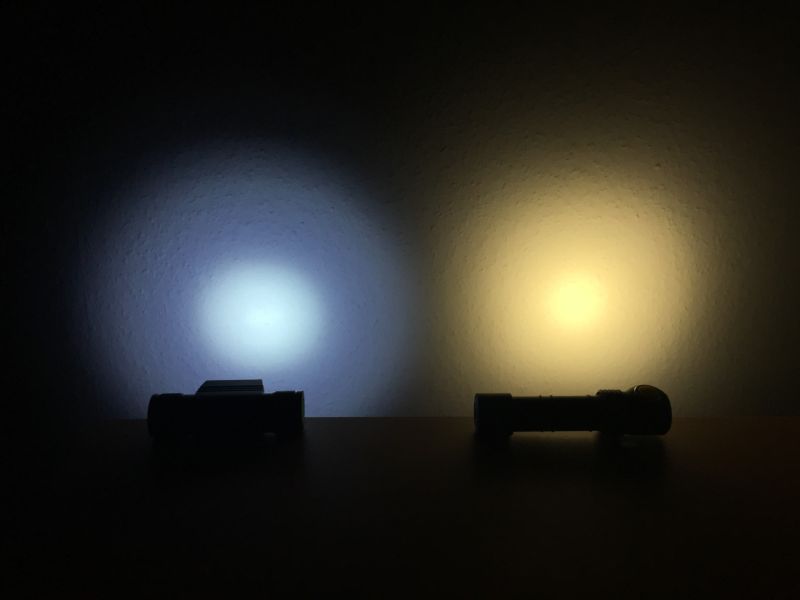


Another downside I found out is some clouded opacity in the very center of the hot spot, probably caused by two light sources that are being overlayed. It appears like a hazy donuthole and is probably not a big issue when using the D25 at farther distances or outside.

4. Conclusion:
What I do like about the D25:
- light-weighted
- a battery is part of the content
- the flashlight appears quite bright and has a useful amount of throw that exceeds typical close range flooding
- the side switch has a good tactile feeling
- the tilt setting in the mount is easy and retains safely at its position
- the hidden microUSB charging port underneath the cap
What I dislike about the D25:
- the XM-L2 LEDs are way too coldwhite/blueish to my opinion
- the beam's center looks clouded but it's only a nuisance when shining at white walls
- the D25 has no real driver but only some resistors that limit the current, so no regulation on current and temperature
- the user interface is very uncommon and not always handy in real life applications
- there's practically no real way to mod the D25 as many parts are not made of standard components, 3535 LEDs cannot be used due to improper footprint and access to the driver can be difficult
- heat transfer is very limited
- the D25 becomes very hot after continuous usage as there is no overheat protection
- threads are made poorly and not lubricated
- lightweight is boon and bane at the same time - low mass leads to rapid heating
- the strap is made very simple and heavy duty usage may cause the D25 to slip from your forehead.
- the price/performance ratio is imbalanced, at least about the undiscounted Amazon price (€ 29.90). At this price level the D25 would have to compete against better lights like Acebeam's H40 or Skilhunt's H03R. It is however being sold under many different brands like Boruit on AliExpress for a reasonable price of $ 13 to 15.
Room for improvement:
- use 3535 emitters in nw/ww CCT (SST-20, XP-L HI, LH351D)
- use mixed configurations of LEDs (e.g. 1x frosted TIR / 1x SMO reflector or 1x XP-E2 red and 1x SST-20)
- use a linear driver with 4-5x 7135 AMCs and a programmable Attiny85, e.g. for NarsilM
- use a standardized, common user interface unless it is customizable
- include a second, detachable overhead strap for more convenience
- use sealing rings where necessary for IPX8 ingress protection
- use a multilanguage user manual (will be hosted on my sharepoint anytime soon)
According to recent news Sofirn plans to launch an improved version of their D25, the D25S. It is meant to come with a better UI and SST-40 LEDs. But basically, I think Sofirn should stick to the well-established quality of their own lights. They should not dilute their great reputation with a non-branded low-end flashlight like D25. Eventually, it is great to hear that with the SP40 we will soon be presented a new self-developed headlamp of Sofirn that hopefully matches both performance and quality of competitors like Convoy H1 or Skilhunt H03R.
Cheers,
Thomas
Well said, Thomas.
My MCU swap helped with a couple of those things, but I stopped short of buying LEDs or creating a new driver from scratch. I just don’t feel like this shell is worth that level of expense and effort.
I too hope that Sofirn kinda just skips messing with the D25 and focuses on getting the SP40 right. Anxiously awaiting that one!
the XM-L2 LEDs
the D25 has no real driver
Those fins inside the tube are meant for the cable ducting between the LEDs and the driver but they appear to work as “cooling fins”, too which is not the best solution as heat would only be transfered onto the battery but not dissipated from the light. After all, the heat transfer is not optimal. During continuous usage both the flashlight and the battery heat up considerately.
Are you sure those are real xm-l2? Previous reports show they are imitation.
No “real” driver? I guess this depends on your definition.
Those fins inside the battery tube have absolutely nothing to due with cooling. I don’t know why people keep think this. It heats up the battery just like a regular flashlights battery tube.
Are you sure those are real xm-l2? Previous reports show they are imitation.
I’m not well versed in this, but here’s how mine look. Can you tell if it’s real/fake? Based on what I’m seeing in RMM’s comment here, I’m not convinced that mine are fake… but I won’t rule it out.
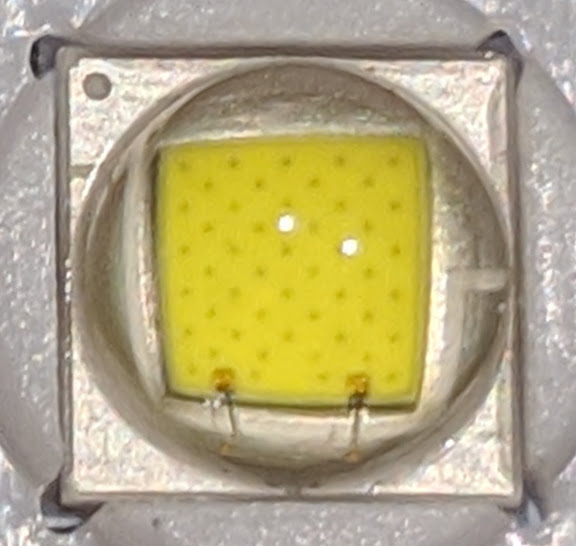
I think the real ones have round pads on the wires. Your picture looks like it has square pads.
I’m not well versed either, but I’ve heard multiple people say the D10 led is a imitation unit. I would assume this also applies to the D25. It’s one of the reasons they can sell it so cheaply.
Are you sure those are real xm-l2? Previous reports show they are imitation.
No, I’m not sure if the XM-L2s are authentic. Since the overall performance of this light is rather low it will not matter to me, though.
No “real” driver? I guess this depends on your definition.
Yes, you‘re right. It’s about how we define a „driver“. IMHO, putting two wires and some resistors in between onto an LED is not what I really call an actual „driver“. Maybe I became too spoiled already. ![]()
Those fins inside the battery tube have absolutely nothing to due with cooling. I don’t know why people keep think this. It heats up the battery just like a regular flashlights battery tube.
I don’t mean to argue about that but one thing is for sure. Those fins inside the battery tube work as a thermal conductor between the hot area underneath the LEDs and the battery, deliberately or not.
It’s about how we define a „driver“. IMHO, putting two wires and some resistors in between onto an LED is not what I really call an actual „driver“. Maybe I became too spoiled already.
Have you read this thread? You know this is a FET driver, right? It’s got two FET’s so I assume it’s a 2 channel driver. The big resistors your referring to are to simply limit the maximum current. So this driver is just as complicated as some of the other 2 channel FET drivers such as the one in the Q8.
The MCU and UI are not as advanced as the Q8’s Atiny 85 and NarsilM, but the basic driver design is similar.
It’s a 1 channel driver with 2 mosfets and resistors in parallel and firmware without stabilization.
Just wanted to add that I have the D25 and I love it. I have several headlamps and this one is by far my favorite just due to the weight and usability (Simple). Seems to hold position well and the brightness levels are good for me. I am thinking of getting the D10 just to see how well it works. Also it’s inexpensive which makes it a great buy.
It’s a 1 channel driver with 2 mosfets and resistors in parallel and firmware without stabilization.
Thanks, I see the FET’s share their inputs and outputs. I should have looked closer. :person_facepalming: I wonder why they used 2 FETs when one should do?
So not quite as complicated as a 2 channel. I guess this makes it difficult to get really low moonlight levels.
On the plus side there is no viable PWM as far as I can see and it has low voltage protection. Two things the old RJ02 suffered from.
D25S headlamp is available on Amazon US now, featuring two SST40 emitters for 1200 lumens and better UI. Check this page
Thanks for the heads-up, Barry. That UI sounds a lot better. It would be nice if Low could be lower than 70 lumens, but still a big improvement. ![]()
Also… Any news on the upcoming SP40A/B?